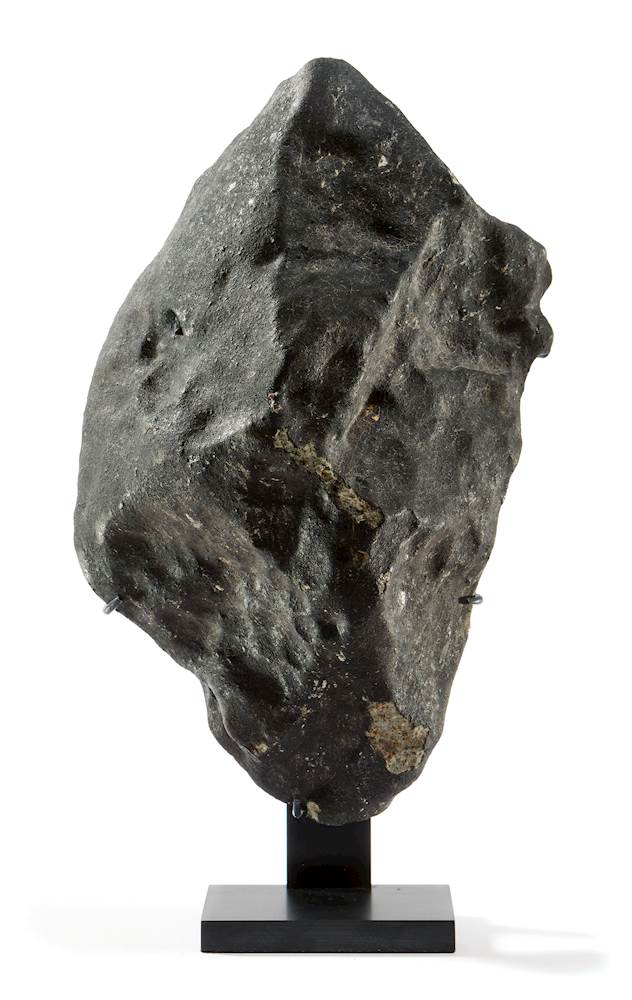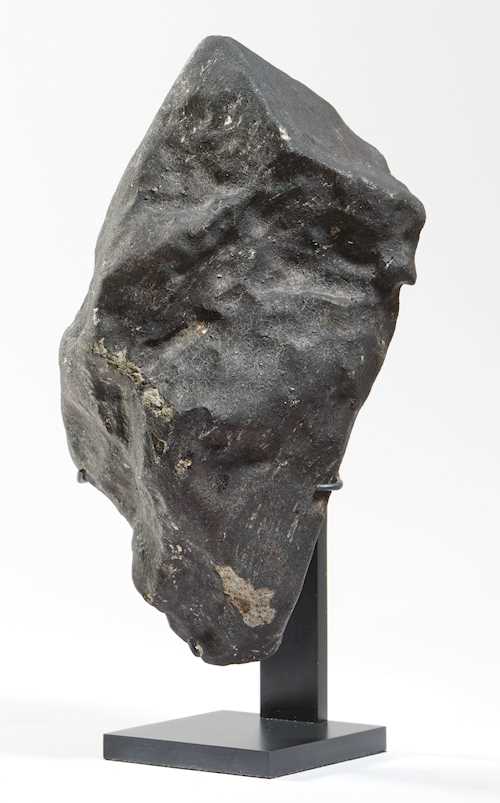
Lot 4034* - A209 Out of This World - Monday, 17. June 2024, 04.00 PM
HAMMADAH AL HAMRA 346 METEORITE
HaH 346
Lybia, Jabal al Gharbi District
Circa 4.56 billion years
1386 g
16.5 × 10 × 7.5 cm (measurements not including stand)
Lybia, Jabal al Gharbi District
Circa 4.56 billion years
1386 g
16.5 × 10 × 7.5 cm (measurements not including stand)
Provenance:
Recovered near Ra’s ash Shuwayrif, Libya, early 2019.
On August 26, 2018, a large fireball was spotted burning through the sky over the Jabal al Gharbi District of Libya. Soon, meteorite hunters began descending on the site, scouring for the pieces of what is now known as the Hammadah al Hamra 346 meteorite.
Upon its entry into the atmosphere, the meteorite would have heated the surrounding air to a temperature of over 1700 C, higher than that of the hottest lava on Earth, and enough to melt away the outer layers of the stone, leaving its surface ripped with regmaglypts, thumb-shaped impressions formed as superheated rock streaked off from the main body as it careened through the atmosphere. The last layer of the stone to melt before its impact has covered the meteorite with a dark matte black fusion crust. Upon closer inspection, the meteorite displays a recrystallised texture predominantly composed of compositionally equilibrated olivine and low-Ca pyroxene grains.
Formed before the creation of the solar system, the result of this meteorite’s journey –freed from its parent body by a powerful collision in outer space and set on a course for our planet – is a wonderfully sculptural form, evidence of the incredible forces endured by this extraterrestrial specimen, reminiscent of the ‘gonshi’, or ‘scholar’s rocks’ that adorned the studios of Imperial China’s literati.
Recovered near Ra’s ash Shuwayrif, Libya, early 2019.
On August 26, 2018, a large fireball was spotted burning through the sky over the Jabal al Gharbi District of Libya. Soon, meteorite hunters began descending on the site, scouring for the pieces of what is now known as the Hammadah al Hamra 346 meteorite.
Upon its entry into the atmosphere, the meteorite would have heated the surrounding air to a temperature of over 1700 C, higher than that of the hottest lava on Earth, and enough to melt away the outer layers of the stone, leaving its surface ripped with regmaglypts, thumb-shaped impressions formed as superheated rock streaked off from the main body as it careened through the atmosphere. The last layer of the stone to melt before its impact has covered the meteorite with a dark matte black fusion crust. Upon closer inspection, the meteorite displays a recrystallised texture predominantly composed of compositionally equilibrated olivine and low-Ca pyroxene grains.
Formed before the creation of the solar system, the result of this meteorite’s journey –freed from its parent body by a powerful collision in outer space and set on a course for our planet – is a wonderfully sculptural form, evidence of the incredible forces endured by this extraterrestrial specimen, reminiscent of the ‘gonshi’, or ‘scholar’s rocks’ that adorned the studios of Imperial China’s literati.
CHF 1 500 / 3 000 | (€ 1 550 / 3 090)
Sold for CHF 2 000 (including buyer’s premium)
All information is subject to change.




